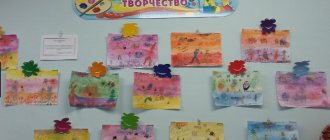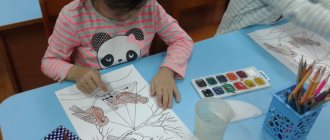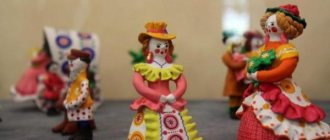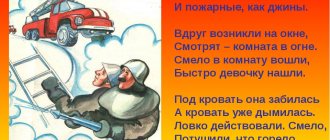Plasticineography - an unconventional modeling technique for preschoolers
Plasticineography as an unconventional modeling technique for preschoolers.
Children draw, sculpt, and assemble figures and buildings from construction sets. In fact, finger training is “fine motor skills of the palms and hands,” which is directly related to the formation of intelligence, the development of speech, memory, attention and thinking.
Scientists have proven that about a third of the area of the cerebral cortex is projected on the hands, and also areas of fine motor movement are very close to the tongue. It is the magnitude of this projection and its proximity to the motor zone that makes it possible to consider the hand as an “organ of speech”, exactly the same as the articular apparatus. In this regard, scientists have put forward the assumption of a significant interaction between fine movements of the hands and fingers on the formation and development of language function in a child.
Motor skills interact with all the higher properties of consciousness: attention, thinking, optical-spatial perception (coordination of movements), observation, visual memory, etc. The development of fine motor skills is also necessary because throughout the rest of one’s life a person will need to use fine, coordinated movements of the hands and fingers that are needed to write and draw, get dressed, and also perform many different household, industrial and educational activities.
Training and motor skills of the fingers primarily occurs with the help of modeling from plasticine, thus, the child’s creative abilities quickly develop, and plasticine also develops fine motor skills of the hands well.
The main thing in working with plasticine is not to overestimate the child’s strength and give him an interesting and exciting task. Then he will feel maximum pleasure from the modeling process and from the results of his work. And this is the key to future success.
In order for a child to really and seriously become interested in modeling from plasticine, and for creativity to bring joy and satisfaction, he should be selected with the necessary and convenient tools for work.
Modeling from plasticine, as already mentioned, is best done on special modeling boards; you can also use a wooden board or a piece of linoleum. The size of the board depends on the size of the product.
Also, the work will require various devices that will allow you to make some details on plasticine figures.
Some plasticine kits already contain a complete set of tools, which, for example, may include a plastic rolling pin. It is convenient to roll out plasticine into even and thin layers.
Types of modeling in kindergarten.
During modeling classes in kindergarten, there are certain tasks for teachers:
- nurturing children's creativity,
- teaching children visual and technical skills,
- developing interest in this type of activity.
Types of modeling in kindergarten: subject; plot; decorative
- Subject modeling: p
Designed for recreating individual objects. Children enthusiastically sculpt figures of people and animals. Only the fastest they master the image of objects of plant and structural form. In connection with this fact, kindergarten teachers are faced with the task of teaching children the ability to depict the key shape of objects in modeling and the most striking features characteristic of them.
- Subject modeling:
is accompanied by a large amount of work, because it is necessary to sculpt each individual object included in the composition, give it the desired position on a stand or without it, and then supplement the sculpting with some details.
- Decorative modeling.
Introducing children to folk applied art is one of the ways of aesthetic education; in the process of learning its various types, in particular the small decorative plastic arts of folk craftsmen, children can acquire many useful skills. The kids are good and happy to sculpt beads and other decorations for dolls, make decorative vessels: egg stands, salt shakers and vases for small spring flowers, trays and glasses for pens and pencils. In the process of working on a decorative plate, children learn the rules of handling the instrument, various modeling techniques, and, more importantly, beautiful decorative filling of space.
"PLASTILINOGRAPHY"
Plasticineography is an unconventional modeling technique, which is expressed in “drawing” with plasticine more or less convex in volume (bas-relief) images on a horizontal surface.
Material for work: plasticine; colored cardboard; markers; ballpoint pen refills; stack; photo frames
Possible tasks:
- improve visual perception.
- promote cognitive, creative and sensorimotor development:
- develop the perception of shape, texture, color, weight, plasticity of the material;
- develop fine motor skills of the hand, synchronization of actions of both hands;
- develop fantasy, imagination, spatial thinking;
- to form the emotional-volitional sphere of children, to develop skills of self-control over the actions performed.
- to promote the socialization of children: the development of their labor skills in planning work to implement a plan, the ability to foresee the result and achieve it.
Types of plasticineography:
1. Direct plasticineography - an image of a molded picture on a horizontal surface.
Mostly all children, starting from an early age, work in this work technique. For an early age, you can prepare a simpler contour drawing, without small details, and at an older age, children can apply more complex compositions on their own, with small details. The drawing is filled with softer plasticine, such as wax. It spreads well and blends beautifully. This technique must be performed on a sheet of thick cardboard, but in this case it is necessary to first cover the surface with tape. It is best to smear plasticine on cardboard with your hands, since the material under pressure lies in an even layer on the surface, thus achieving the effect of a brush stroke with oil paints.
2. Reverse plasticineography - an image of a stucco painting on the reverse side of a transparent surface or stained glass.
This type of plasticineography is used on glass, the image is obtained from the other side, which is why it is called reverse plasticineography. Since preschool children cannot work on glass, you can use plastic or plexiglass.
Transfer the design to the surface using a marker, and then fill the elements of the design with plasticine. To do this, you need to select a piece of plasticine according to size and knead it well in your hands, and then smear it on the glass. You can smear it with your fingers or a glass, carefully pressing it onto the surface to form a thin layer. The new color must be applied sequentially and separately. Along the contour, the resulting work can be pasted over with stripes to create a neat frame, or inserted into a finished frame.
3. Modular plasticineography - an image of a molded picture using various elements - rollers, balls, disks.
This technique is more complex, since it requires mastery of all sculpting techniques. First, you need to transfer the drawing you like onto a sheet of cardboard and fill each section of the picture with plasticine of the appropriate color, which can be done with small balls, flagella or whole parts, giving the edges the desired shape using a stack.
4. Mosaic plasticineography - an image of a molded picture using plasticine balls.
This technique is the simplest, since the elements are all the same - plasticine balls. You just need to beautifully combine colors and carefully fill the space without going beyond the outline
5. Contour plasticineography - image of an object using flagella.
This technique is more suitable for older people, as it requires perseverance and painstaking work. The contour drawing is filled with flagella, which are pre-rolled by the child himself or prepared in advance by the teacher. To do this, you need to place the plasticine in a syringe, and place the syringe in hot water so that the plasticine melts. After 2-3 minutes, you can squeeze out the plasticine, so you can prepare completely identical flagella, which subsequently fill the space.
6. Multilayer plasticineography - a three-dimensional image of a stucco painting with the sequential application of several layers.
The advantage of this technique is that you can create a very beautiful and bright plot on a plane. This technique is suitable for depicting the sky, mountains, forests and other landscape scenes, when one layer on top is covered by another. Some details of the plasticine painting may have a complex outline. In this case, you need to apply a plasticine cake and remove excess plasticine using a stack.
If the painting contains elements that are difficult to sculpt, then they are repeated with a thin layer of plasticine on paper, cut out with scissors and stuck to the base using thin plasticine rollers, thus achieving a 3-D effect.
7. Textured plasticineography - an image of large areas of a painting on a horizontal surface with a more convex image (bas-relief, high relief, counter-relief)
Bas-relief (French bas-relief - low relief) Bas-relief is a common type of decoration of architectural structures, a type of sculptural convex relief in which the image protrudes above the background plane by no more than half the volume. If more, the relief is called high relief
(high relief
). The picture can be made in relief in different ways - by forming elements using a stack, by sculpting individual parts that will protrude on the surface. Counter-relief (from the Latin contra - against and “relief”) is a type of in-depth relief, which is a “negative” of the bas-relief.
This type of in-depth relief can be achieved using rollers with a printed pattern. It is necessary to roll out the plate, first level it with a rolling pin, and then apply the pattern with a roller or stamp. How to arrange and store plasticine paintings. Flat plasticine paintings are best placed under glass in a frame, mat, or stored under transparent film. Plasticine paintings should not be deformed, exposed to direct sunlight or heat. Author: Khairulina E.V.
How to make animals from plasticine. Master Class
Modeling from plasticine for children 5-6 years old is no longer difficult, since most of the techniques have already been mastered. With the help of step-by-step instructions, a child of this age can easily sculpt a cute figurine of this tiger, consisting of simple parts.
The sequence for creating a tiger is as follows:
- 1/3 of a block of bright orange plasticine is cut off. Both resulting pieces are rolled into balls.
- The small ball will be the tiger's head. From the second ball, part of the plasticine is pulled out into an oblong body.
- Using a toothpick or match, connect the head and body together.
- From the second block of orange plasticine, 1/3 of the part from which the hind legs are made is also cut off. This part must be kneaded and divided into 2 equal pieces, which should be shaped like a cone. Form feet on the wide side of the cone.
- For the front paws, a piece of plasticine is rolled into a sausage, then cut into 2 parts. Paws with thickened feet are made from them.
- Stick the paws to the tiger's body.
- Roll up and stick to the body a long tail made of thin sausage.
- Make small round ears with indentations and attach them to the head.
- Use white cakes and a nose from pink plasticine to create an animal's face.
- The tiger's eyes are made from round cakes of white, green and black, stuck on top of each other. You can add highlights around the edges of the eye.
- Attach a white chest made from a strip of plasticine on which wool is drawn in a stack to the neck.
- White cakes are glued to the hind legs as pads and toes.
- Now you need to create black stripes. A very thin sausage is rolled out of black plasticine, short sections of which are stuck all over the tiger's body. Also, claws on the hind legs are made from them and glued into the indentations of the toe pads made by the stack.
- Using a stack, make cuts to mark the toes of the front paws. 15 Use a toothpick to make dots on the white part of the tiger cub’s face.
The plasticine tiger is ready.






